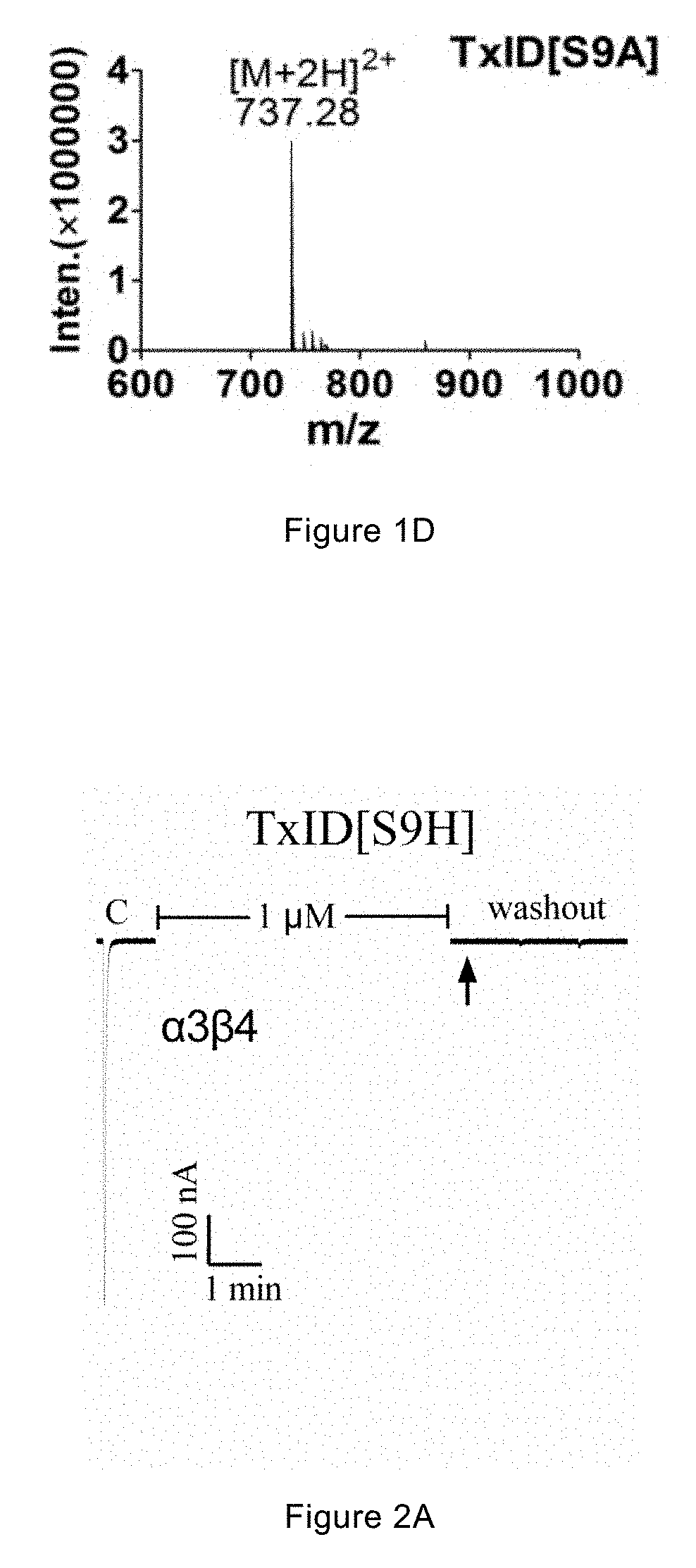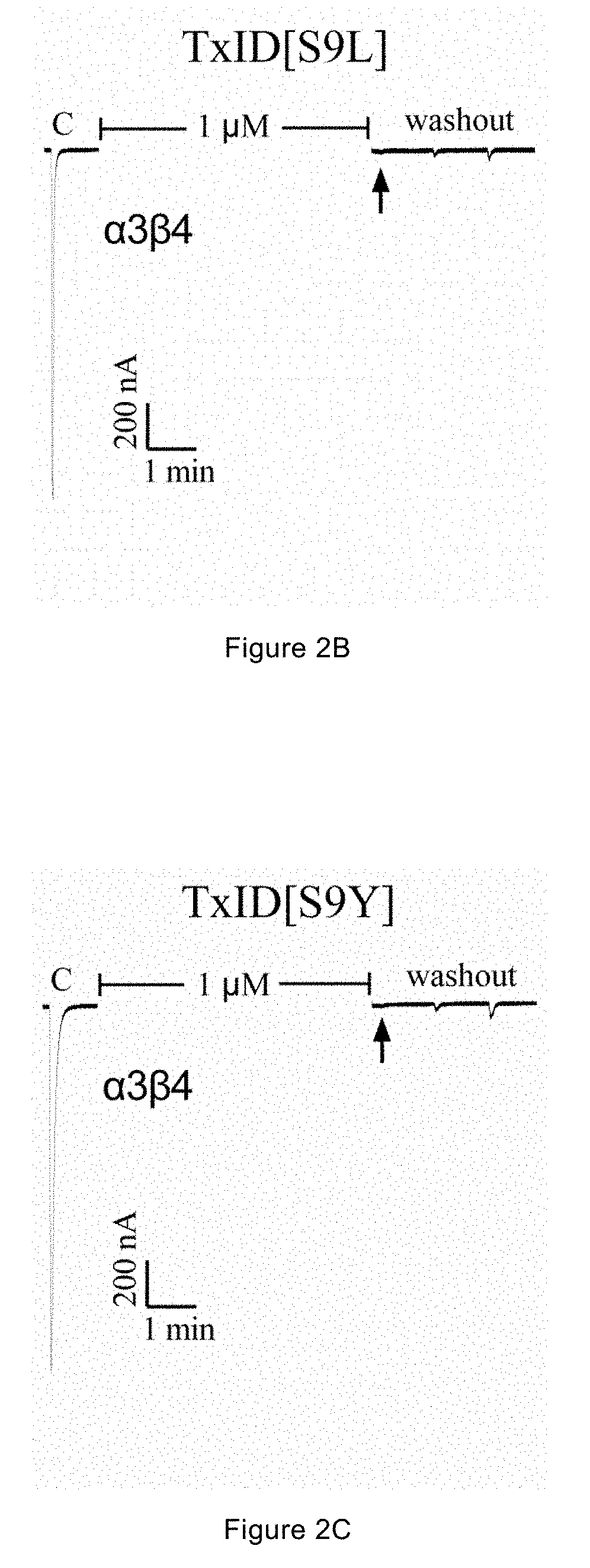NOVEL MUTANT OF a-CONOTOXIN PEPTIDE TxID, PHARMACEUTICAL COMPOSITION AND USE THEREOF
a technology of a-conotoxin and a-conotoxin, applied in the field of biochemistry and molecular biology, can solve the problems of drug addiction, both a medical problem and a serious social problem, and the difficulty of self-control or the difficulty of correcting application behavior, and achieve the effect of good discrimination
- Summary
- Abstract
- Description
- Claims
- Application Information
AI Technical Summary
Benefits of technology
Problems solved by technology
Method used
Image
Examples
example 2
t of α-Conotoxin TxID New Mutant Specifically Blocking α3β4 nAChR Subtype
[0113]Referring to the methods in the literature (Luo S, Zhangsun D, Zhu X, Wu Y, Hu Y, Christensen S, Harvey P J, Akcan M, Craik D J, McIntosh J M. Characterization of a novel α-conotoxin TxID from Conus textile that potently blocks rate α3β4 nicotinic acetylcholine receptors. Journal of Medicinal Chemistry. 2013, 56: 9655-9663. Azam L, Yoshikami D, McIntosh J M. Amino acid residues that confer high selectivity of the alpha6 nicotinic acetylcholine receptor subunit to alpha-conotoxin MII[S4A,E11A,L15A]. J Biol Chem. 2008; 283(17):11625-32.), as well as the specification of in vitro transcription kit (mMessage mMachine in vitro transcription kit (Ambion, Austin, Tex.)), various rat neural nAChRs subtypes (α3β4, α6 / α3β4, α9α10, α4β2, α4β4, α3β4, α2β2, α2β4, α7), human α3β4 and α6 / α3β4, and mouse muscular nAChRs (α1β1δε) cRNA were prepared, and their concentrations were measured and calculated by OD values at UV ...
example 3
t of α-Conotoxin TxID New Mutants Specifically Blocking α6 / α3β4 nAChR Subtypes
[0123]Referring to the electrophysiological method in Example 2, the blocking activities of TxID and all polypeptides of its new mutant in Table 1 against α6 / α3β4 (equivalent to α6β4*, * representing the remaining possible subunits) nAChR were determined, and the results were shown in Table 2, as well as FIGS. 7A-7D, FIGS. 8A-8D, FIGS. 9A-9D, FIGS. 10A-10D, and FIGS. 11A-11C. The ratios of the blocking activities of these mutants to α6 / α3β4 nAChR compared to TxID were also summarized in Table 2.
[0124]The results show:
[0125]Total of 24 new peptides, SEQ ID NOs: 2-3, 7, 9, 11-23, 25-30 and 33 (prepared in Example 1), had different degrees of blocking effect on rat α6 / α3β4 nAChR (please See Table 2, and FIGS. 7A-7D, FIGS. 8A-8D and FIGS. 9A-9D), and half-blocking doses (IC50) ranging from 4.91 nM to 3492.82 nM (Table 2).
[0126]Among them, most of the mutants in total of 22 polypeptides maintained blocking acti...
example 4
n of Activities of α-Conotoxin TxID New Mutants on Two Subtypes of α3β4 and α6 / α3β4 nAChR
[0130]The present inventors compared the activities of the α-conotoxin TxID new mutants on the two subtypes of α3β4 and α6 / α3β4 nAChR according to the experimental data in Table 2 above, in which the comparison results were expressed by the degrees of discrimination, the degree of discrimination=(IC50 of mutant on rat α6 / α3β4) / IC50 of mutant on rat α3β4), and the unit was nM. The results are shown in Table 3 below. In addition, the inventors also list the currently known conotoxins acting on α3β4 nAChRs and their discriminations between two very similar subtypes α3β4 and α6 / α3β4 nAChR in Table 3 by literature investigation.
TABLE 3Alpha-conotoxins acting on α3β4 and α6 / α3β4 acetylcholine receptor subtypes and their discrimination for the two subtypesSEQIDα3β4α6 / α3β4Discrim-Selectivity toNO:NameSequence aSourceIC50[nM]IC50[nM]ination bnAChR subtypeReference d1TxIDGCCSHPVCSAMSPIC*C. textile3.64 33....
PUM
| Property | Measurement | Unit |
|---|---|---|
| Fraction | aaaaa | aaaaa |
| Composition | aaaaa | aaaaa |
Abstract
Description
Claims
Application Information
 Login to View More
Login to View More - R&D
- Intellectual Property
- Life Sciences
- Materials
- Tech Scout
- Unparalleled Data Quality
- Higher Quality Content
- 60% Fewer Hallucinations
Browse by: Latest US Patents, China's latest patents, Technical Efficacy Thesaurus, Application Domain, Technology Topic, Popular Technical Reports.
© 2025 PatSnap. All rights reserved.Legal|Privacy policy|Modern Slavery Act Transparency Statement|Sitemap|About US| Contact US: help@patsnap.com



